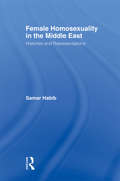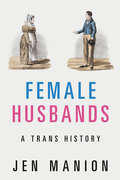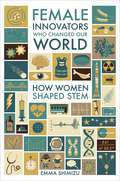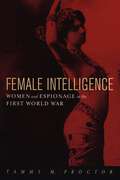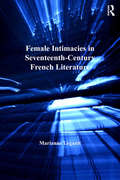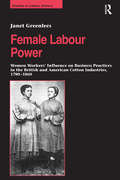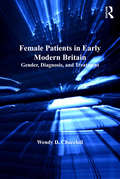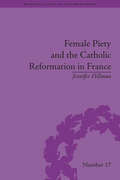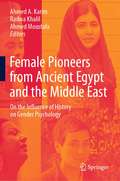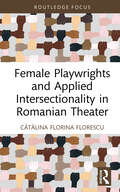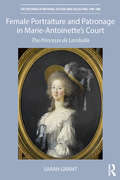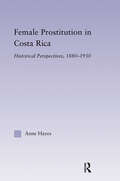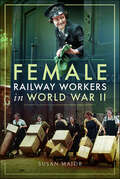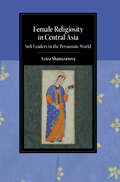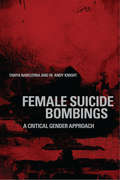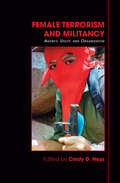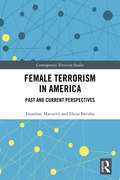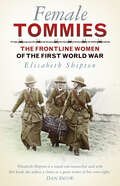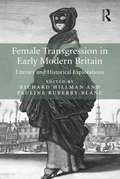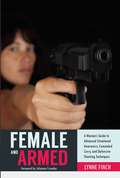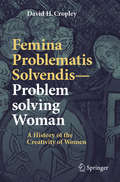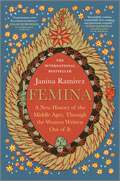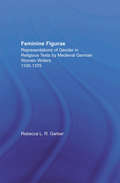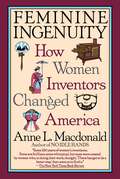- Table View
- List View
Female Homosexuality in the Middle East: Histories and Representations (Routledge Research in Gender and Society)
by Samar HabibThis book, the first full-length study of its kind, dares to probe the biggest taboo in contemporary Arab culture with scholarly intent and integrity - female homosexuality. Habib argues that female homosexuality has a long history in Arabic literature and scholarship, beginning in the ninth century, and she traces the destruction of Medieval discourses on female homosexuality and the replacement of these with a new religious orthodoxy that is no longer permissive of a variety of sexual behaviours. Habib also engages with recent "gay" historiography in the West and challenges institutionalized constructionist notions of sexuality.
Female Husbands: A Trans History
by Jen ManionLong before people identified as transgender or lesbian, there were female husbands and the women who loved them. Female husbands - people assigned female who transed gender, lived as men, and married women - were true queer pioneers. Moving deftly from the colonial era to just before the First World War, Jen Manion uncovers the riveting and very personal stories of ordinary people who lived as men despite tremendous risk, danger, violence, and threat of punishment. Female Husbands weaves the story of their lives in relation to broader social, economic, and political developments in the United States and the United Kingdom, while also exploring how attitudes towards female husbands shifted in relation to transformations in gender politics and women's rights, ultimately leading to the demise of the category of 'female husband' in the early twentieth century. Groundbreaking and influential, Female Husbands offers a dynamic, varied, and complex history of the LGBTQ past.
Female Innovators Who Changed Our World: How Women Shaped STEM (Trailblazing Women Ser.)
by Emma GreenWe are not all born with equal opportunities. Yet there have been countless of women who have overcome a range of barriers such as prejudice, illness, and personal tragedy to advance our understanding of science, technology, engineering, and mathematics (STEM). They used their knowledge to change the world, and their stories are fascinating. This book offers a concise introduction of the lives of 46 women, taking you into the cultural and social context of the world they lived in. Through their intelligence, courage, and resilience, they used STEM to defy expectations and inspire generations to follow in their footsteps. Some of them invented items we use day-to-day and discovered causes and treatments for epidemics that ostracised whole sections of society, whilst others campaigned for the reproductive rights of women and harnessed mathematics to send people into space and break ciphers. These women are proof that females can and did have a hugely significant role in shaping the world we live in today.
Female Intelligence: Women and Espionage in the First World War
by Tammy M. ProctorWhen the Germans invaded her small Belgian village in 1914, Marthe Cnockaert’s home was burned and her family separated. After getting a job at a German hospital, and winning the Iron Cross for her service to the Reich, she was approached by a neighbor and invited to become an intelligence agent for the British. Not without trepidation, Cnockaert embarked on a career as a spy, providing information and engaging in sabotage before her capture and imprisonment in 1916. After the war, she was paid and decorated by a grateful British government for her service.Cnockaert’s is only one of the surprising and gripping stories that comprise Female Intelligence. This is the first history of the female spies who served Britain during World War I, focusing on both the powerful cultural images of these women and the realities, challenges, and contradictions of intelligence service. Between the founding of modern British intelligence organizations in 1909 and the demobilization of 1919, more than 6,000 women served the British government in either civil or military occupations as members of the intelligence community. These women performed a variety of services, and they represented an astonishing diversity of nationality, age, and class. From Aphra Behn, who spied for the British government in the seventeenth century, to the most well known example, Mata Hari, female spies have a long history, existing in juxtaposition to the folkloric notion of women as chatty, gossipy, and indiscreet. Using personal accounts, letters, official documents and newspaper reports, Female Intelligence interrogates different, and apparently contradictory, constructions of gender in the competing spheres of espionage activity.
Female Intimacies in Seventeenth-Century French Literature (Women And Gender In The Early Modern World Ser.)
by Marianne LegaultExamining literary discourses on female friendship and intimacy in seventeenth-century France, this study takes as its premise the view that, unlike men, women have been denied for centuries the possibility of same sex friendship. The author explores the effect of this homosocial and homopriviledged heritage on the deployment and constructions of female friendship and homoerotic relationships as thematic narratives in works by male and female writers in seventeenth-century France. The book consists of three parts: the first surveys the history of male thinkers' denial of female friendship, concluding with a synopsis of the cultural representations of female same-sex practices. The second analyzes female intimacy and homoerotism as imagined, appropriated and finally repudiated by Honoré d'Urfé's pastoral novel, L'Astrée, and Isaac de Benserade's seemingly lesbian-friendly comedy, Iphis et Iante. The third turns to unprecedented depictions of female intimate and homoerotic bonds in Madeleine de Scudéry's novel Mathilde and Charlotte-Rose de Caumont de La Force's fairy tale Plus Belle que Fée. This study reveals a female literary genealogy of intimacies between women in seventeenth-century France, and adds to the research in lesbian and queer studies, fields in which pre-eighteenth-century French literary texts are rare.
Female Labour Power: Women Workers’ Influence on Business Practices in the British and American Cotton Industries, 1780–1860 (Studies in Labour History)
by Janet GreenleesBritain and America were the first two countries with mechanised cotton manufacturing industries, the first major factory systems of production and the first major employers of women outside of the domestic environment. The combination of being new wage earners in the first trans-national industry and their public prominence as workers makes these women's role as employees significant; they set the early standard for women as waged labour, to which later female workers were compared. This book analyses how women workers influenced patterns of industrial organization and offers a new perspective on relationships between gender and work and on industrial development. The primary theme of the study is the attempt to control the work process through co-operation, coercion and conflict between women workers, their male counterparts and manufacturers. Drawing upon examples of women's subversive activities and attitudes toward the discourses of labour, the book emphasizes the variety of women's work experiences. By using this diversity of experience in a comparative way, the book reaches conclusions that challenge a variety of historical concepts, including separate spheres of influence for men and women and related economic theories, for example that women were passive players in the workplace, evolutionary theories with respect to industrial development, and business culture within and between the two industries. Overall it provides the fresh approach that highlights and explains women's agency as operatives and paid workers during industrialization.
Female Monasticism in Early Modern Europe: An Interdisciplinary View (Catholic Christendom, 1300-1700)
by Cordula Van WyheThis volume of twelve interdisciplinary essays addresses the multifaceted nature of female religious identity in early modern Europe. By dismantling the boundaries between the academic disciplines of history, art history, musicology and literary studies it offers new cross-cultural readings essential to a more comprehensive understanding of the complexity of female spirituality in the sixteenth and seventeenth centuries. Utilising a wide range of archival material, encompassing art, architecture, writings and music commissioned or produced by nuns, the volume's main emphasis is on the limitations and potentials created by the boundaries of the convent. Each chapter explores how the personal and national circumstances in which the women lived affected the formation of their spirituality and the assertion of their social and political authority. Consisting of four sections each dealing with different parts of Europe and discussing issues of spiritual and social identity such as 'Femininity and Sanctity', 'Convent Theatre and Music-Making', 'Spiritual Directorship' and 'Community and Conflict', this compelling collection offers a significant addition to a thriving new field of study.
Female Patients in Early Modern Britain: Gender, Diagnosis, and Treatment (The History of Medicine in Context)
by Wendy D. ChurchillThis investigation contributes to the existing scholarship on women and medicine in early modern Britain by examining the diagnosis and treatment of female patients by male professional medical practitioners from 1590 to 1740. In order to obtain a clearer understanding of female illness and medicine during this period, this study examines ailments that were specific and unique to female patients as well as illnesses and conditions that afflicted both female and male patients. Through a qualitative and quantitative analysis of practitioners' records and patients' writings - such as casebooks, diaries and letters - an emphasis is placed on medical practice. Despite the prevalence of females amongst many physicians' casebooks and the existence of sex-based differences in the consultations, diagnoses and treatments of patients, there is no evidence to indicate that either the health or the medical care of females was distinctly disadvantaged by the actions of male practitioners. Instead, the diagnoses and treatments of women were premised on a much deeper and more nuanced understanding of the female body than has previously been implied within the historiography. In turn, their awareness and appreciation of the unique features of female anatomy and physiology meant that male practitioners were sympathetic and accommodating to the needs of individual female patients during this pivotal period in British medicine.
Female Piety and the Catholic Reformation in France (Religious Cultures in the Early Modern World #17)
by Jennifer HillmanHillman presents a fascinating account of the role that women played during the Catholic Reformation in France. She reconstructs the devotional practices of a network of powerful women showing how they reconciled Catholic piety with their roles as part of an aristocratic elite, challenging the view that the Catholic Reformation was a male concern.
Female Pioneers from Ancient Egypt and the Middle East: On the Influence of History on Gender Psychology
by Ahmed Moustafa Ahmed A. Karim Radwa KhalilThis book explores the contributions of Eastern female pioneers in science, politics and arts from Ancient Egypt to modern times, and discusses the possible psychological and social impact of this knowledge on today’s gender role in Eastern and Western Societies. Based on psychological studies on social learning, the book argues that profound knowledge of the historical contributions of Eastern female pioneers in science, politics and arts can improve today’s gender roles in Middle Eastern countries and inspire young women living in Western Societies with Eastern migration background. Spanning disciplines such as Natural sciences, Neuroscience, Psychology, Sociology, Islamic Theology, History and Arts, and including contributions from diverse geographical regions across the world, this book provides an elaborate review of the gender role of women in Ancient Egypt and the Middle East, outlining their prominence and influence and discusses the possible psychological and social impact of this knowledge on today’s gender roles.
Female Playwrights and Applied Intersectionality in Romanian Theater (Routledge Advances in Theatre & Performance Studies)
by Cătălina Florina FlorescuIn this collection, the author focuses on several contemporary Romanian female playwrights with residencies in Europe and the U.S.: Alexandra Badea, Carmen Francesca Banciu, Alexa Băcanu, Ana Sorina Corneanu, Mihaela Drăgan, Dr. Cătălina Florina Florescu, Dr. Mihaela Michailov, Dr. Domnica Rădulescu, Saviana Stănescu, and Dr. Elise Wilk. In their bold works, written by female playwrights who are academics, activists, and performers, we are invited to discover variations in the modus operandi of the dramatic language itself from metaphorical to matter-of-fact approaches. Furthermore, while all these playwrights speak Romanian, they also think and operate in various other languages, such as Romani, German, French, Italian, and American English. This book facilitates scholars and students to discover contemporary issues related to Romanian society as presented heavily from a feminine angle and to reveal intersectional issues as seen and applied to dramatic characters in a post-communist country from some authors who experienced communism firsthand. The book is also an invitation to reinvent how we teach dramatic literature by offering 20 interactive, exploratory activities.
Female Portraiture and Patronage in Marie Antoinette's Court: The Princesse de Lamballe (The Histories of Material Culture and Collecting, 1700-1950)
by Sarah GrantThis comprehensive book brings to light the portraits, private collections and public patronage of the princesse de Lamballe, a pivotal member of Marie-Antoinette’s inner circle. Drawing extensively on unpublished archival sources, Sarah Grant examines the princess’s many portrait commissions and the rich character of her private collections, which included works by some of the period’s leading artists and artisans. The book sheds new light on the agency, sorority and taste of Marie-Antoinette and her friends, a group of female patrons and model of courtly collecting that would be extinguished by the coming revolution.
Female Prostitution in Costa Rica: Historical Perspectives, 1880-1930
by Anne HayesThis book analyzes the development of female prostitution in the Pacific port of Puntarenas, Costa Rica during the advanced stage of the coffee exporting economy (1880-1930), at the height of the consolidation of the liberal state. Hayes argues that prostitution in the port differed from that of the coffee producing highlands due to differential economic, social, and political development. In the periphery of Puntarenas, the development of prostitution reflected a less stigmatized view of sexual commerce than that of the highlands, where prostitution, although legal, threatened the tenets of liberal nationalism based on racial homogeneity and family values. Women of the highlands were encouraged to reproduce the nation's "more European" stock of workers and to ensure the legal transference of property through legal church marriages - both part of a design to stabilize the coffee exporting project. By contrast, prostitutes and other working women of Puntarenas, many immigrants from the "less European" populations of neighboring regions and most in concubinage, were freer to do what the law prescribed - register as prostitutes in legitimate trade. Such regional disparities reveal weaknesses in traditional explanations of Costa Rican exceptionalism, which have rested on the premise of cultural homogeneity and have reflected the realities of only one region of the country. The book advances an alternative explanation for the development of the nation's more democratic institutions, situating Costa Rican exceptionalism in the nation's free labor system, of which the labor prostitute in Puntarenas provides an example.
Female Railway Workers in World War II
by Susan MajorDuring World War II women took on railway roles which were completely new to females. They worked as porters and guards, on the permanent way, and in maintenance and workshop operations. In this book Susan Major features the voices of women talking about their wartime railway experiences, using interviews by the Friends of the National Railway Museum. Many were working in ‘men’s jobs’, or working with men for the first time, and these interviews offer tantalising glimpses of conditions, sometimes under great danger. What was it about railway work that attracted them? It’s fascinating to contrast their voices with the way they were portrayed in official publicity campaigns and in the light of attitudes to women working in the 1940s. These women talk about their difficulties in a workplace not designed for women – no toilets for example, the attitudes of their families, what they thought about American GIs and Italian POWs, how they coped with swearing and troublesome colleagues, rules about stockings. They describe devastating air raids and being thrust into tough responsibilities for the first time. This book fills a gap, as most books on women’s wartime roles focus on the military services or industrial work. It offers valuable insights into the perceptions and concerns of these young women. As generations die out and families lose a direct connection, it becomes more important to be able to share their voices with a wider audience.
Female Religiosity in Central Asia: Sufi Leaders in the Persianate World (Cambridge Studies in Islamic Civilization)
by Aziza ShanazarovaThrough revealing the fascinating story of the Sufi master Aghā-yi Buzurg and her path to becoming the 'Great Lady' in sixteenth-century Bukhara, Aziza Shanazarova invites readers into the little-known world of female religious authority in early modern Islamic Central Asia, revealing a far more multifaceted gender history than previously supposed. Pointing towards new ways of mapping female religious authority onto the landscapes of early modern Muslim narratives, this book serves as an intervention into the debate on the history of women and religion that views gender as a historical phenomenon and construct, challenging narratives of the relationship between gender and age in Islamic discourse of the period. Shanazarova draws on previously unknown primary sources to bring attention to a rich world of female religiosity involving communal leadership, competition for spiritual superiority, and negotiation with the political elite that transforms our understanding of women's history in early modern Central Asia.
Female Suicide Bombings: A Critical Gender Approach
by Tanya Narozhna W. Andy KnightAs media coverage of terrorism and terroristic acts has increased so too has the discussion about the identities, motives, and gender of the perpetrators. Over the past fifteen years, there have been over 150 reported suicide bombings committed by women around the world. Because of its prominence in media reporting, the phrase "female suicide bomber" has become loaded with gendered notions and assumptions that elicit preconditioned responses in the West. Female Suicide Bombings critically examines and challenges common assumptions of this loaded term. Tanya Narozhna and W. Andy Knight introduce female suicide bombings as a socio-political practice and a product of deeply politicized, gendered representations. Drawing on a combination of feminist and post-colonial approaches as well as terrorism studies literature, the authors seek to transcend ideological divisions in order to enhance our understanding of how gender, power, and academic practices influence our perceptions of female suicide bombings.
Female Terrorism and Militancy: Agency, Utility, and Organization (Contemporary Terrorism Studies)
by Cindy D. NessThis edited volume provides a window on the many forces that structure and shape why women and girls participate in terrorism and militancy, as well as on how states have come to view, treat, and strategize against them. Females who carry out terrorist acts have historically been seen as mounting a challenge to the social order by violating conventional notions of gender and power, and their participation in such acts has tended to be viewed as being either as a passive victim or a feminist warrior. This volume seeks to move beyond these portrayals, to examine some of the structuring conditions that play a part in a girl or woman’s decision to commit violence. Amidst the contextual factors informing her involvement, the volume seeks also to explore the political agency of the female terrorist or militant. Several of the articles are based on research where authors had direct contact with female terrorists or militants who committed acts of political violence, or with witnesses to such acts.
Female Terrorism in America: Past and Current Perspectives (Contemporary Terrorism Studies)
by Jonathan Matusitz Elena BerishaThis book provides a comprehensive analysis of female terrorism in America, both past and present. The volume takes a fresh look at women’s actions of left-wing political violence, right-wing political violence, and religious extremist violence (among others). It also examines the multitude of roles that women have played over the past few decades in such organizations (including leadership positions and more passive roles)—not to mention the diverse methods of recruitment, radicalization, and propaganda. The objective of this book is to examine—using a wide range of case studies, facts, statistics, and theoretical methodologies—how collective or personal factors have influenced or reinforced the actions that these women take. Government agencies continue to underestimate the ability of women to support and perpetrate terrorism. As such, the United States is facing a wholly inaccurate and incomplete picture of the complexities of domestic terrorism, and this is contributing to a serious neglect of the issue at the national level. This volume ultimately aims to offer policy-relevant solutions to decrease the threat of domestic female political violence in the United States. Female Terrorism in America will be of much interest to students of terrorism and political violence, American politics, gender studies, and sociology.
Female Tommies: The Frontline Women of the First World War
by Elisabeth ShiptonThis book tells the story of women in the First World War at the front line, under fire, and in combat. Through their diaries, letters and memoirs, meet the women who defied convention and followed their convictions to defend the less fortunate and fight for their country. Follow British Flora Sandes as she joins the Serbian Army and takes up a place in the rear-guard of the Iron Regiment as they retreat from the Bulgarian advance. Stow away with Dorothy Lawrence as she smuggles herself to Paris, steals a uniform and heads to the Front. Enlist in Russia’s all-female ‘Battalion of Death’ alongside peasant women and princesses alike. Through the letters, diaries and memoirs of women who were members of organisations such as the US Army Signal Corps, the Canadian Army Medical Corps, the FANY, WRAF, WRNS, WAAC and many others, we learn what life was like for them on the front and discover the courage of the women who took up arms.
Female Transgression in Early Modern Britain: Literary and Historical Explorations
by Richard Hillman Pauline Ruberry-BlancPresenting a broad spectrum of reflections on the subject of female transgression in early modern Britain, this volume proposes a richly productive dialogue between literary and historical approaches to the topic. The essays presented here cover a range of ’transgressive’ women: daughters, witches, prostitutes, thieves; mothers/wives/murderers; violence in NW England; violence in Scotland; single mothers; women as (sexual) partners in crime. Contributions illustrate the dynamic relation between fiction and fact that informs literary and socio-historical analysis alike, exploring female transgression as a process, not of crossing fixed boundaries, but of negotiating the epistemological space between representation and documentation.
Female and Armed: A Woman?s Guide to Advanced Situational Awareness, Concealed Carry, and Defensive Shooting Techniques
by Lynne Finch Julianna CrowderIn Female and Armed Lynne Finch offers an information-packed follow-up to her first book, Taking Your First Shot. Based on questions and requests from readers, this book addresses more advanced techniques for personal defense as well as range drills to help readers practice and hone those skills. It’s important to know how to defend yourself, and Finch provides the building blocks necessary to successfully navigate some dangerous, real-life scenarios. Be it a carjacking, robbery, or home invasion, readers will learn how to protect themselves and their family. Female and Armed introduces readers to more advanced situational awareness techniques and builds upon their previous shooting experience by teaching them how to responsibly handle and carry a concealed handgun. Finch covers the advances in female holsters and discusses the various ways to carry, as well as the importance of having a primary carry method. In addition to this, topics include handgun retention, defensive draw stroke and defensive reloading, shooting from an unstable platform, and shooting from within a car. Knowing how to handle yourself can make all the difference in a stressful and dangerous situation. This guide also includes defensive tactics when confronted by an assailant armed with a gun or knife. Brimming with full-color photos, this approachable guide is written in Finch’s distinctive conversational and nonthreatening style. It is great for the novice shooter looking to advance and for the more experienced shooter looking for tips to improve her shooting.
Femina Problematis Solvendis—Problem solving Woman: A History of the Creativity of Women
by David H. CropleyThis book explores the history of modern human creativity/innovation, highlighting examples of solutions to basic human’ needs that have been developed over time. The title – Femina Problematis Solvendis – is a play on the scientific classifications of humans (Homo habilis, Homo erectus, Homo sapiens), but with special focus on inventions pioneered by women (“femina”) and is intended to suggest that a defining characteristic of modern humans is our fundamental ability to solve problems (i.e., problem-solving woman = Femina problematis solvendis), Written by David H. Cropley, an internationally recognised expert on creativity and innovation, it also builds on his previous book “Homo Problematis Solvendis –Problem-solving Man”, published in 2019. The book explores innovations over ten distinct “ages” of human history, beginning with “prehistory”, and moving up to the present “information age”. Each era is covered by a dedicated chapter that describes three key innovations that were either definitely invented by a woman or can be plausibly attributed to a female inventor. The book’s focus on female inventors also serves to highlight some of the ways women have been treated in societies over time.
Femina: A New History of the Middle Ages, Through the Women Written Out of It
by Janina RamirezA groundbreaking reappraisal of medieval femininity, revealing why women have been written out of history and why it matters The Middle Ages are seen as a bloodthirsty time of Vikings, saints and kings; a patriarchal society that oppressed and excluded women. But when we dig a little deeper into the truth, we can see that the &“Dark&” Ages were anything but. Oxford and BBC historian Janina Ramirez has uncovered countless influential women&’s names struck out of historical records, with the word FEMINA annotated beside them. As gatekeepers of the past ordered books to be burned, artworks to be destroyed, and new versions of myths, legends and historical documents to be produced, our view of history has been manipulated. Only now, through a careful examination of the artifacts, writings and possessions they left behind, are the influential and multifaceted lives of women emerging. Femina goes beyond the official records to uncover the true impact of women, such as: Jadwiga, the only female king in Europe Margery Kempe, who exploited her image and story to ensure her notoriety Loftus Princess, whose existence gives us clues about the beginnings of Christianity in England In Femina, Ramirez invites us to see the medieval world with fresh eyes and discover why these remarkable women were removed from our collective memories.
Feminine Figurae: Representations of Gender in Religious Texts by Medieval German Women Writers, 1100-1475 (Studies in Medieval History and Culture #10)
by Rebecca L.R. GarberFirst Published in 2003. Routledge is an imprint of Taylor & Francis, an informa company.
Feminine Ingenuity: Women and Invention in America
by Anne Macdonald"Written with clarity and a lively eye both for detail and for the progress of feminism in the United States."SAN FRANCISCO CHRONICLEIn this fascinating study of American women inventors, historian Anne Macdonald shows how creative, resourceful, and entrepreneurial women helped to shatter the ancient stereotypes of mechanically inept womanhood. In presenting their stories, Anne Macdonald's thorough research in patent archives and her engaging use of period magazine, journals, lectures, records from major fairs and expositions, and interviews, have made her book nothing less than an overall history of the women's movement in America.From the Trade Paperback edition.
